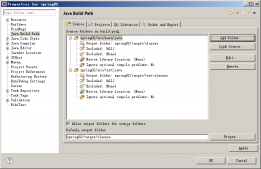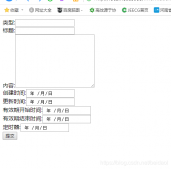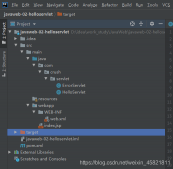在工作中,我们用到分布式缓存的时候,第一选择就是Redis,今天介绍一下SpringBoot如何集成Redis的,分别使用Jedis和Spring-data-redis两种方式。
一、使用Jedis方式集成
1、增加依赖
<!-- spring-boot-starter-web不是必须的,这里是为了测试--> <dependency> <groupId>org.springframework.boot</groupId> <artifactId>spring-boot-starter-web</artifactId> </dependency> <dependency> <groupId>org.projectlombok</groupId> <artifactId>lombok</artifactId> <optional>true</optional> </dependency> <dependency> <groupId>redis.clients</groupId> <artifactId>jedis</artifactId> </dependency> <dependency> <!-- fastjson不是必须的,这里是为了测试--> <groupId>com.alibaba</groupId> <artifactId>fastjson</artifactId> <version>1.2.73</version> </dependency>
2、配置项
redis.host=localhost redis.maxTotal=5 redis.maxIdle=5 redis.testOnBorrow=true #以下方式也可以,SpringBoot同样能将其解析注入到JedisPoolConfig中 #redis.max-total=3 #redis.max-idle=3 #redis.test-on-borrow=true
3、配置连接池
/**
* @author 公-众-号:程序员阿牛
* 由于Jedis实例本身不非线程安全的,因此我们用JedisPool
*/
@Configuration
public class CommonConfig {
@Bean
@ConfigurationProperties("redis")
public JedisPoolConfig jedisPoolConfig() {
return new JedisPoolConfig();
}
@Bean(destroyMethod = "close")
public JedisPool jedisPool(@Value("${redis.host}") String host) {
return new JedisPool(jedisPoolConfig(), host);
}
}
4、测试
/**
* @author 公-众-号:程序员阿牛
*/
@RestController
public class JedisController {
@Autowired
private JedisPool jedisPool;
@RequestMapping("getUser")
public String getUserFromRedis(){
UserInfo userInfo = new UserInfo();
userInfo.setUserId("A0001");
userInfo.setUserName("张三丰");
userInfo.setAddress("武当山");
jedisPool.getResource().set("userInfo", JSON.toJSONString(userInfo));
UserInfo userInfo1 = JSON.parseObject(jedisPool.getResource().get("userInfo"),UserInfo.class);
return userInfo1.toString();
}
}
运行结果如下:

我们可以自己包装一个RedisClient,来简化我们的操作
使用spring-data-redis
1、引入依赖
<dependency> <groupId>org.springframework.boot</groupId> <artifactId>spring-boot-starter-data-redis</artifactId> </dependency>
2、配置项
在application.properties中增加配置
spring.redis.host=localhost spring.redis.port=6379
3、使用
/**
* @author 公-众-号:程序员阿牛
*/
@RestController
public class RedisController {
@Autowired
private RedisTemplate redisTemplate;
@RequestMapping("getUser2")
public String getUserFromRedis(){
UserInfo userInfo = new UserInfo();
userInfo.setUserId("A0001");
userInfo.setUserName("张三丰");
userInfo.setAddress("武当山");
redisTemplate.opsForValue().set("userInfo", userInfo);
UserInfo userInfo1 = (UserInfo) redisTemplate.opsForValue().get("userInfo");
return userInfo1.toString();
}
}
是的,你只需要引入依赖、加入配置就可以使用Redis了,不要高兴的太早,这里面会有一些坑
4、可能会遇到的坑

使用工具查看我们刚才set的内容,发现key前面多了一串字符,value也是不可见的
原因
使用springdataredis,默认情况下是使用org.springframework.data.redis.serializer.JdkSerializationRedisSerializer这个类来做序列化
具体我们看一下RedisTemplate 代码如何实现的
/**
*在初始化的时候,默认的序列化类是JdkSerializationRedisSerializer
*/
public void afterPropertiesSet() {
super.afterPropertiesSet();
boolean defaultUsed = false;
if (this.defaultSerializer == null) {
this.defaultSerializer = new JdkSerializationRedisSerializer(this.classLoader != null ? this.classLoader : this.getClass().getClassLoader());
}
...省略无关代码
}
如何解决
很简单,自己定义RedisTemplate并指定序列化类即可
/**
* @author 公-众-号:程序员阿牛
*/
@Configuration
public class RedisConfig {
@Bean
public RedisTemplate<String, Object> redisTemplate(RedisConnectionFactory connectionFactory) {
RedisTemplate<String, Object> template = new RedisTemplate<>();
template.setConnectionFactory(connectionFactory);
template.setValueSerializer(jackson2JsonRedisSerializer());
//使用StringRedisSerializer来序列化和反序列化redis的key值
template.setKeySerializer(new StringRedisSerializer());
template.setHashKeySerializer(new StringRedisSerializer());
template.setHashValueSerializer(jackson2JsonRedisSerializer());
template.afterPropertiesSet();
return template;
}
@Bean
public RedisSerializer<Object> jackson2JsonRedisSerializer() {
//使用Jackson2JsonRedisSerializer来序列化和反序列化redis的value值
Jackson2JsonRedisSerializer serializer = new Jackson2JsonRedisSerializer(Object.class);
ObjectMapper mapper = new ObjectMapper();
mapper.setVisibility(PropertyAccessor.ALL, JsonAutoDetect.Visibility.ANY);
mapper.enableDefaultTyping(ObjectMapper.DefaultTyping.NON_FINAL);
serializer.setObjectMapper(mapper);
return serializer;
}
}/**
* @author 公-众-号:程序员阿牛
*/
@Configuration
public class RedisConfig {
@Bean
public RedisTemplate<String, Object> redisTemplate(RedisConnectionFactory connectionFactory) {
RedisTemplate<String, Object> template = new RedisTemplate<>();
template.setConnectionFactory(connectionFactory);
template.setValueSerializer(jackson2JsonRedisSerializer());
//使用StringRedisSerializer来序列化和反序列化redis的key值
template.setKeySerializer(new StringRedisSerializer());
template.setHashKeySerializer(new StringRedisSerializer());
template.setHashValueSerializer(jackson2JsonRedisSerializer());
template.afterPropertiesSet();
return template;
}
@Bean
public RedisSerializer<Object> jackson2JsonRedisSerializer() {
//使用Jackson2JsonRedisSerializer来序列化和反序列化redis的value值
Jackson2JsonRedisSerializer serializer = new Jackson2JsonRedisSerializer(Object.class);
ObjectMapper mapper = new ObjectMapper();
mapper.setVisibility(PropertyAccessor.ALL, JsonAutoDetect.Visibility.ANY);
mapper.enableDefaultTyping(ObjectMapper.DefaultTyping.NON_FINAL);
serializer.setObjectMapper(mapper);
return serializer;
}
}
查看运行结果:

哨兵和集群
只需要改一下配置项即可
# 哨兵 spring.redis.sentinel.master=mymaster spring.redis.sentinel.nodes=127.0.0.1:26379,127.0.0.1:26380,127.0.0.1:26381 #集群 spring.redis.cluster.max-redirects=100 spring.redis.cluster.nodes=127.0.0.1:6379,127.0.0.1:6380,127.0.0.1:6381,127.0.0.1:6382,127.0.0.1:6383,127.0.0.1:6384
总结:
以上两种方式都可以,但是还是建议你使用Spring-data-redis,因为Spring经过多年的发展,尤其是Springboot的日渐成熟,已经为我们简化了很多操作。
到此这篇关于详解Spring集成Redis的两种方式的文章就介绍到这了,更多相关Spring集成Redis 内容请搜索服务器之家以前的文章或继续浏览下面的相关文章希望大家以后多多支持服务器之家!
原文链接:https://www.cnblogs.com/coderaniu/p/15347479.html















